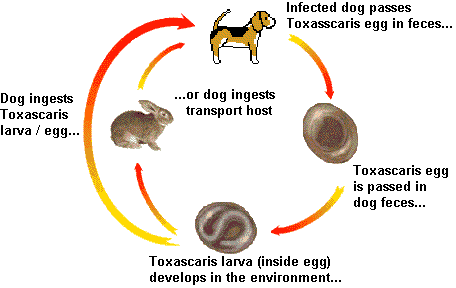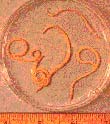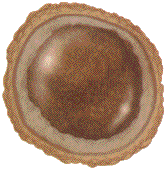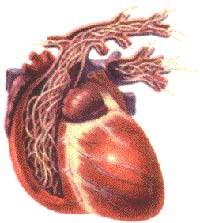 |
|
|
Worms and PreventionParasitic worms are as common as fleas to dogs and especially to puppies. From the half-inch- long hookworms to the flat, segmented tapeworms that can reach three feet in length. But in most cases, worm detection is easy and treatment is effective. The most common worms to dogs in the United States are the roundworm, tapeworm, whipworm, and hookworm -- which live primarily in the dog’s intestine and the heartworm, which lives within the heart and in the blood vessels leading from the heart to the lungs. For discount Wormers -- click here.
HOW INFECTION OCCURS: In dogs, there are four ways by which infection with Toxocara canis occurs:
 EFFECTS ON DOG Roundworm infection can have numerous negative effects. It is a common cause of diarrhea in young animals and can cause vomiting as well. Sometimes the worms themselves are vomited up which can be alarming as they can be quite large which females reaching lengths of up to seven inches. The worms consume the host’s food and can lead to unthriftiness and a classical “pot-bellied” appearance. Very heavy infections can lead to pneumonia as the worms migrate and, if there are enough worms, the intestine can actually become obstructed. It should also be noted that human infection by this parasite is especially serious (see below). It is important to minimize the contamination of environmental soil with the feces of infected animals so as to reduce the exposure hazard to both humans and other animals. HOW DO YOU KNOW IF OUR DOG IS INFECTED?
Of course, there are ways to find out if your dog is infected. If a dog or puppy vomits up a worm, there is a good chance this is a roundworm (especially in a puppy). Roundworms are long, white and described as looking like spaghetti. Tapeworms can also be vomited up but these are flat and obviously segmented. If you are not sure what type of worm you are seeing, bring it to your vet’s office for identification. Fecal testing for worm eggs is a must for puppies and a good idea for adult dogs having their annual check up. Obviously, if there are worms present, they must be laying eggs in order to be detected but, by and large, fecal testing is a reliable method of detection. HOW DO YOU GET RID OF ROUNDWORMS? Common active ingredients include:
Milbemycin Oxime (active ingredient of Interceptor and Sentinel) This means that you will likely see the worms when they pass so be prepared as they can be quite long and may still be alive and moving when you see them. The other concept is stems from the fact that larvae in migration cannot be killed by any of these products. After the worms are cleared from the intestine, they will be replaced by new worms completing their migration. This means that a second, and sometimes even a third deworming is needed to keep the intestine clear. The follow-up deworming is generally given several weeks following the first deworming to allow for migrating worms to arrive in the intestine where they are vulnerable. Do not forget your follow-up deworming. The roundworm known as Toxocara canis is the most common, and puppies are often born with an infection. In the mother dog, the resting roundworm larvae are activated by hormones during pregnancy, and the larvae then cross the placenta to infect the unborn puppies. Less commonly, the larvae are carried in the mother’s milk into the newborn puppies. Within a few weeks after birth, puppies who were born with roundworm larvae will discharge roundworms eggs in their feces. The mother dog then reinfects herself by ingesting the eggs when she licks her puppies clean. Intestinal parasites are also transmitted to your pets by other animals contaminating the soil. The infected animal will defecate the worm or the eggs. These eggs will then develop into a microscopic larvae. The larvae will then attach itself to your pet’s paws and migrate through the body, eventually ending up in the intestine of your pet. Tape worm is transmitted by the ingestion of fleas or the ingestion of infected rodents. As stated earlier, treatment is doubly important because worms can be transmitted to people. These include certain species of tapeworms, roundworms, hookworms, and some other, less common types of parasites. The same larvae infecting your pet can migrate into a person and cause either a skin infection or in some cases an internal infection to the liver. This disease is called visceral larval migrans. This is why it is recommended to deworm all puppies, even if the fecal analysis is negative. While the three-inch adult roundworms are usually a minor problem for adult dogs, a serious infection of roundworms or hookworms can be life threatening to a puppy because of blood and protein loss, or dehydration. Tapeworms are flat worms that are segmented. They consist of a head, neck, and then a number of segments. The head usually has suckers that enable the tapeworm to attach itself to the animal’s intestine. Each tapeworm segment has its own reproductive organs. New segments are continually formed in the neck region of the worm while those at the end of the tapeworm are cast off as they mature. These mature segments contain large numbers of eggs which are often grouped into packets. The segments may often be seen near the anus of the dog or cat. These segments may move if recently passed or, if dried, they look like grains of uncooked rice or cucumber seeds. Tapeworm infections are usually diagnosed by finding these segments on the animal. Tapeworms all have life cycles that include an intermediate host. These hosts include fleas, fish, and domestic animals. All of the adult forms of these tapeworms live in the dog’s digestive system. Tapeworms have no digestive systems themselves, but absorb nutrients through their skin. The adult worm, which can be up to 20 inches long, lives in the small intestine. The segments, full of eggs, are passed in the feces. While warm, the segments are active, but as they dry, they break open and liberate the eggs inside. Either an adult louse or a flea larva ingests the eggs. The egg develops into an immature form in the insect. When a dog or cat eats the insect, the immature form develops into an adult and the life cycle is completed. How is an infection with D. caninum diagnosed? The diagnosis of a D. caninum infection can be diagnosed by finding the moving segments, dried segments, and occasionally by seeing eggs in the feces if the segment had ruptured. What are the signs of a D. caninum infection? In heavy infections, you may notice abdominal discomfort or nervousness in the animal. The animal may vomit and sometimes have convulsions. It is thought that the convulsions are due to toxins produced by the tapeworm. The active segments around the anal area may cause an animal to lick or 'scoot' on the floor. What signs of infection do we see in humans? Usually it is children who become infected with this tapeworm by ingesting flea larvae or adult lice. In general, we rarely see symptoms in humans. In severe infections, abdominal discomfort, diarrhea and pruritus (itching) in the perianal area may be present. How do you treat and prevent infections with D. caninum in dogs and cats? The most common treatment is praziquantel which is found in Droncit. The dose is determined by number of tablets per body weight. It can not be used in pregnant animals. The drug epsiprantel (Cestex) is also effective, but cannot be used in puppies and kittens less than 7 weeks of age. The most important preventive measures are flea control and lice control. Numerous products are on the market which can be used for this purpose. It is recommended to not only treat the animals but also the environment in an attempt to kill as many flea larvae as possible.
In many cases, a dog owner will note the signs of worm infection, or it will be detected during a regular checkup when your veterinarian does a microscopic exam of your dog’s stool sample. Heartworm detection requires a blood test. Your veterinarian can easily make a specific diagnosis and begin effective worm treatments that usually cause little discomfort to your dog. Heartworm treatment is an exception. It is dangerous and risky to treat for adult heartworm, even with the new adulticide. To prevent heartworm infection, your dog should be treated with preventive medications. Year round heartworm preventative treatment is recommended. Minor worm infections can be of little significance, but nearly all these parasites will induce serious disease if present in overwhelming numbers. Many dogs have various levels of immunity, or at least some resistance to many worm species. It is not unusual for a normal adult dog to have small populations of adult roundworms and hookworms, as well as resting larvae, in body tissues. However, if your dog is stressed, the larvae can be stimulated to develop into a large, threatening population in the dog’s intestines. The stress can be triggered by traveling, malnutrition, medications such as corticosteroids, or other infection. The growing population of parasites could then absorb more nutrients, draw the host’s body fluids (such as blood or lymph), cause anemia by destroying red blood cells, destroy tissue, trigger inflammatory reactions, or cause other complex responses. Not all gastrointestinal signs, such as diarrhea are caused by worms. A change in your dog’s appetite or bowel habits may result from causes other than a worm infection, or a worm infection may be minor and possibly be kept in check by your dog’s immune system. One risk from an unnecessary or inappropriate treatment is that some internal parasites can develop resistance to some treatments, making the drugs less effective later when they may be needed. While there are over-the-counter worm medicines, their common use can result in a drug being applied to the wrong parasite, which may leave the real threat undiminished. An observant dog owner can recognize adult roundworms in vomit or stool, and can see whitish tapeworm segments in stool. These are about as big as a rice grain, and can crawl - even on your dog’s fur! Because infected dogs also often shed microscopic worm eggs, the best advice is to have the dog screened by a veterinarian. Some of the common signs of worm infections are listed below, but these may also be symptoms of other illnesses. When ever your pet is acting ill, we always recommend an examination of your pet and an analysis of a fecal sample.
Steps to Prevent Worm Infections: Prevent your dog from eating animal carcasses, such as rabbits and rodents, which may contain immature tape worms that will mature in your dog. Maintain good hygiene. For instance, whipworm and roundworm eggs dropped to the soil in your dog’s feces can remain infectious for years, while hook worm larvae can accumulate in the earth of a dog run. All can reinfect your dog. Rapid removal of feces is important. Pave over your dog run. This is much safer than having a soil or gravel surface in which worms can survive.
Heartworms live in the right side of the heart and the large arteries
running from the heart to the lungs (the pulmonary arteries). With adult male and female worms present, mating begins to occur. Heartworms do not lay eggs like other worm parasites; instead they give live birth and the baby worms are called Microfilariae. Microfilariae are released into the circulatory system in hope that they will be slurped up by a mosquito taking a blood meal and carried to a new host.
It is very important to regularly worm your dogs for heartworm. There are many traditional ways to do this. Some are expensive ($5 - $10/mo.) and some are very inexpensive (<$1/mo.) For many years a large number of beaglers have chosen to take care of the problem prevention in the following inexpensive way... (this is in no way a recommendation -- just a long known, money saving fact) Ivomec injectable for swine -- .1cc (one tenth of a cc) per 10 lbs of body weight for beagles monthly as a preventative (so 20 lb beagle would get .2cc). Given orally -- squirting it onto a piece of bread and watching them eat it works well, as does mixing it with cola or orange juice (taking the needle off the syringe) and squirting it from the syringe into the back of their throat. (Also kills ear mites if .25cc is squirted in each ear -- 3 days in a row.) Safeguard horse wormer paste (about an inch squeezed out per dog) is usually given for most other worms (does not work on heartworm). Usually the Ivomec is given each month that mosquitos are out (because of heartworm) and Safeguard is given in the colder months when there is little risk of heartworm transmission because there are no mosquitos out. BECAUSE OF THE FIVE MONTH MINIMUM MIGRATION TIME OF THE LARVAL HEARTWORM AFTER INFECTION, IT IS OF NO USE TO HEARTWORM TEST DOGS YOUNGER THAN FIVE MONTHS OF AGE. THESE PUPPIES ARE TOO YOUNG TO BE INFECTED UNDER ANY CIRCUMSTANCES. WHEN TO START GIVING HEARTWORM PREVENTIVE EACH YEAR? For discount Wormers -- click here. None of this information is guaranteed to be accurate -- always consult your veterinarian prior to making a decision on your pet's health. |
As an Amazon Associate we earn from qualifying purchases.
An absolute must have for any sporting dog owner. Save money on vet bills!
|
|||||||||
Beagles & Rabbit Hunting Videos - DVD - FREE shipping!
Rabbit Hunting Online is a participant in the Amazon Services LLC Associates Program, an affiliate advertising program designed to provide a means for sites to earn advertising fees by advertising and linking to Amazon.com |


 Hookworms
present a far more serious threat to both the mother and puppies. These
are blood sucking parasites and will cause a severe anemia and if not
promptly treated death. We recommend stool examinations on all puppies
at 6-8 weeks of age.
Hookworms
present a far more serious threat to both the mother and puppies. These
are blood sucking parasites and will cause a severe anemia and if not
promptly treated death. We recommend stool examinations on all puppies
at 6-8 weeks of age.
 Heartworm
disease causes damage to the pulmonary arteries which eventually leads
to heart failure. If you have any acquaintances with chronic heart
failure, ask them how much joy there is in their lives. Heart failure
robs the dog of its ability to play comfortably. Eventually it becomes
difficult to just participate in normal activities. Serious damage
begins to occur in other organ systems affected by the heart failure.
Treatment of the symptoms alone fails to resolve the problem over the
long term and the dog eventually dies -- after having been miserable
for some time. Some dogs do manage to live almost normal lifespans
despite infection with Heartworms but they are very lucky. A rough
estimate is that 80% of dogs affected with Heartworms probably die
from the heartworm disease before something else causes them to die
and >90% eventually show some or all of the symptoms of the disease.
Heartworm
disease causes damage to the pulmonary arteries which eventually leads
to heart failure. If you have any acquaintances with chronic heart
failure, ask them how much joy there is in their lives. Heart failure
robs the dog of its ability to play comfortably. Eventually it becomes
difficult to just participate in normal activities. Serious damage
begins to occur in other organ systems affected by the heart failure.
Treatment of the symptoms alone fails to resolve the problem over the
long term and the dog eventually dies -- after having been miserable
for some time. Some dogs do manage to live almost normal lifespans
despite infection with Heartworms but they are very lucky. A rough
estimate is that 80% of dogs affected with Heartworms probably die
from the heartworm disease before something else causes them to die
and >90% eventually show some or all of the symptoms of the disease.
